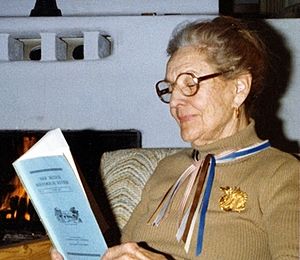Sophie Bledsoe Aberle facts for kids
Quick facts for kids
Sophie Bledsoe Aberle
|
|
|---|---|

Aberle in her New Mexico home, 1982
|
|
| Born |
Sophie Bledsoe Herrick
July 21, 1896 Schenectady, New York, U.S.
|
| Died | October 1996 (aged 100) Albuquerque, New Mexico, U.S.
|
| Occupation | Anthropologist, physician, and nutritionist |
| Known for | Work with Pueblo people |
Sophie Bledsoe Aberle (born Sophie Herrick; July 21, 1896 – October 1996) was an amazing American scientist. She was an anthropologist, a doctor (physician), and a nutritionist. She is famous for her important work with the Pueblo people. Sophie Aberle was also one of the first two women ever chosen to be on the National Science Board.
Contents
Early Life and Education
Sophie Bledsoe Herrick was born in 1896. Her parents were Albert and Clara S. Herrick. She grew up in Schenectady, New York. Sophie's grandmother, also named Sophia Bledsoe Herrick, was a writer.
Sophie was taught at home when she was young. At age 21, she had a short marriage to a man named Aberle. She decided to keep his last name.
College and Degrees
Sophie first went to the University of California in Berkeley. She then moved to Stanford University. There, she earned her first degree in 1923. She got a master's degree in 1925. In 1927, she earned a Ph.D. in genetics.
After that, she went to medical school. She became a doctor (M.D.) at Yale University in 1930. While studying, she worked as an assistant. She helped with histology (studying tissues) and embryology (studying how living things develop). She also worked in neurology (studying the brain and nerves). Sophie also taught anthropology.
Career and Research
Sophie Aberle started her career teaching at Yale for four years. But she spent most of her working life helping Native American communities.
Working with Native Americans
From 1935 to 1944, she worked for the Bureau of Indian Affairs. This group helps Native American tribes. After that, she worked for the National Research Council until 1949. Then, from 1949 to 1954, she worked at the University of New Mexico.
In 1948, Sophie published her first big book. This book showed that she strongly supported the land rights of the Pueblo people. She believed they should control their own land.
National Science Board
In 1951, something very special happened. President Harry Truman chose Sophie Aberle for the National Science Board. She and Gerty Cori were the first two women ever appointed to this important board. Sophie stayed a member until 1957.
Later, she worked as the chief nutritionist at the Bernalillo County Indian Hospital. She did this until 1966. Then she went back to the University of New Mexico. She became a professor of psychiatry. She held this job until she retired in 1970.
Helping Communities
Sophie Aberle spent a lot of her career on committees. These groups worked on land issues and health. She was part of many important committees.
For example, she was on the health committee for the All Indian Pueblo Council. She also worked with the New Mexico Nutrition Committee. She even helped with the White House Conference on Children in Democracy. Sophie also led the board for a training school for federal service. She was also part of a group that looked at the rights of American Indians.
Professional Memberships
Sophie Aberle was a member of several important professional groups:
- American Association for the Advancement of Science
- American Anthropological Association
- American Medical Association
Works
Sophie Aberle wrote important books about her work:
- The Pueblo Indians of New Mexico, Their Land, Economy and Civil Organization
- The Indian: America's Unfinished Business
See also
 In Spanish: Sophie Bledsoe Aberle para niños
In Spanish: Sophie Bledsoe Aberle para niños

